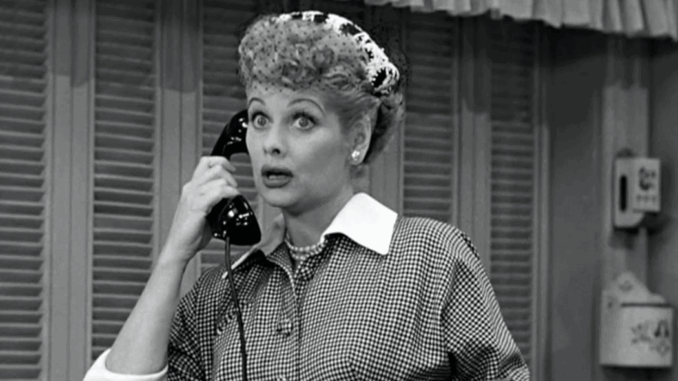
When you think of classic television, I Love Lucy immediately comes to mind. With its slapstick humor, iconic redhead Lucille Ball, and the undeniable chemistry with Desi Arnaz, it might seem like a charming relic of a bygone era. But to dismiss I Love Lucy as merely an “old sitcom” would be a colossal oversight. In reality, this groundbreaking show, which first aired in the 1950s, was a revolutionary force, inventing and perfecting techniques that modern giants like Netflix and HBO Max are still replicating in their most popular comedies today.
1. The Birth of the Multi-Cam Sitcom: Immersive Comedy
Before I Love Lucy, most television shows were shot single-camera, much like movies. This often resulted in static, theatrical presentations. Desi Arnaz, a visionary behind the scenes, was instrumental in developing the multi-camera setup, using three cameras simultaneously to capture action from different angles.
- The I Love Lucy Innovation: This allowed for seamless editing between wide shots and close-ups, creating a more dynamic and engaging viewing experience. It captured the energy of a live performance while offering cinematic quality.
- Modern Echoes: This multi-cam format became the standard for decades of sitcoms, from Friends and Seinfeld to The Big Bang Theory. Even today, while single-cam shows like The Office or Ted Lasso are popular, traditional sitcoms on networks and streaming services frequently employ the multi-cam setup for their live-audience feel. Shows like Netflix’s The Ranch or even the recent That ’90s Show directly inherit this visual legacy, creating that familiar, cozy, and immediate comedic rhythm.
2. The Power of the Live Studio Audience: Authenticity and Contagion
The decision to film I Love Lucy in front of a live studio audience was a deliberate choice that transformed the comedic landscape.
- The I Love Lucy Innovation: The genuine laughter and reactions from a live audience provided immediate feedback for the performers, influencing pacing and comedic timing. It also made the home viewer feel like they were part of a shared, communal experience. The audience’s laughter wasn’t just background noise; it was an integral part of the show’s comedic punch.
- Modern Echoes: The live studio audience remains a hallmark of many successful sitcoms across platforms. Shows like Friends (now streaming on Max/Netflix depending on region), The Big Bang Theory, and even some newer streaming comedies actively embrace this. The audience laughter is a critical component, signaling jokes and creating a shared emotional response. The feeling of being “in the room” with the characters and the collective laughter remains a powerful tool for comedy.
3. The Re-Run Revolution: The Blueprint for Binge-Watching
In a groundbreaking move, Desi Arnaz insisted on filming I Love Lucy on 35mm film, a much higher quality format than the kinescopes typically used for live television broadcasts.
- The I Love Lucy Innovation: This meant the episodes could be re-broadcast with excellent quality, essentially inventing the concept of the “re-run.” This allowed the show to reach new audiences and for existing fans to re-watch their favorite episodes repeatedly. It created enduring popularity long after the initial broadcast.
- Modern Echoes: This foresight directly laid the groundwork for today’s streaming and binge-watching culture. Netflix and HBO Max thrive on extensive libraries of content that viewers can re-watch endlessly. From Friends being a perennial favorite on Max to The Office dominating Netflix’s watch hours, the power of the re-run, first harnessed by Lucy and Desi, is the very foundation of streaming success. They understood that quality content has timeless appeal.
4. Character-Driven Comedy and Relatability: Humanizing the Laughs
Beyond the gags, I Love Lucy was profoundly character-driven. Lucy Ricardo’s outlandish schemes were always rooted in relatable human desires: to be famous, to impress, to escape mundane life. Ricky’s exasperation and genuine love, Fred and Ethel’s bickering friendship – these were real relationships.
- The I Love Lucy Innovation: The humor sprang organically from the characters’ personalities, flaws, and dynamics, rather than just isolated jokes. Viewers connected with Lucy not just because she was funny, but because she was flawed, ambitious, and deeply human.
- Modern Echoes: This is a cornerstone of virtually every successful modern sitcom. From the deeply flawed but lovable ensemble of Friends to the awkward but relatable characters of The Office on Peacock (formerly Netflix), or the relentlessly optimistic and kind Ted Lasso on Apple TV+, character relatability drives the humor. We laugh with them, not just at them, because their motivations, even when silly, feel real.
5. The Power Couple as a Central Hub: Chemistry That Drives the Show
The undeniable, off-screen and on-screen chemistry between Lucille Ball and Desi Arnaz was the beating heart of I Love Lucy. Their real-life marriage infused the show with an authenticity and spark that was irreplaceable.
- The I Love Lucy Innovation: Their dynamic, a blend of passionate love, cultural differences, and comedic friction, became the central engine for nearly every plotline. Their personal connection elevated the show from just funny sketches to a beloved narrative.
- Modern Echoes: While not always a real-life couple, the “power couple” or central romantic/platonic pairing often forms the emotional core of modern sitcoms. Think of Jim and Pam on The Office, or Leslie Knope and Ben Wyatt on Parks and Recreation (streaming on Peacock), or even the deep platonic love between the core Friends group. Their relationships provide an emotional anchor, driving both humor and heart, a formula perfected by Lucy and Desi.
So, the next time you’re binge-watching your favorite comedy on Netflix or Max, take a moment to consider its lineage. Did Lucy write the modern comedy formula all along? It’s certainly a strong case to be made!

